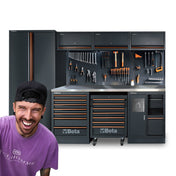15 Garage Workshop Storage Tips
· Workshop Tool Storage
A tidy garage workshop isn’t about having more space—it’s about using the space you have. These practical tips help you organise tools, parts, and projects for faster, safer work.

1) Map your zones before you move a thing
Sketch your floor plan and group activities: cutting, assembly, finishing, mechanics, and storage. Keep tools, power and consumables for each zone within arm’s reach.
Pro tip: Place dust-heavy tools near extraction and the external door.
2) Climb the walls (safely)
Use vertical real estate with a mix of French cleats, slatwall, and steel pegboard. Cleats handle heavy fixtures, pegboard suits visible hand tools, slatwall excels at flexible hooks and bins.
Anchor into studs or masonry with rated fixings and verify load capacities.
3) Put the ceiling to work
Overhead racks store seasonal or bulky items. Keep clear zones above the vehicle and garage door travel. Use cargo nets or straps to stop shift.
4) Standardise your storage system
Pick one cabinet and bin format and stick to it. Matching drawer depths and bin sizes let you reconfigure without chaos. Add adjustable feet to cabinets and locking castors to mobile bases.
Consider modular systems that integrate tall cabinets, base drawers, and panels for future upgrades.
5) Drawers for small stuff, shelves for big stuff
Hand tools, bits, and consumables live best in drawers with dividers or foam; large tools and cases belong on shelves or in tall cabinets. If it’s heavy or used weekly, keep it low; light or rare, keep it high.
6) Build a fastener station
Use labelled bins for screws, nuts, bolts, and anchors. Keep a small scoop, magnet, and calipers there. Decant mixed packs immediately—future you will thank you.
7) Make key tools mobile
A rolling tool cart or mobile workbench turns dead corners into active space. Park carts under benches when not in use and add a power strip for chargers or soldering irons.
8) Sort lumber & pipe properly
Install a wall-mounted cantilever rack for timber and conduit. Store longest stock high; short offcuts go in a vertical bin. Use stickers (spacers) when drying boards to keep airflow.
9) Tame cords and hoses
Fit reels for air and power where you work most. Use wraps or Velcro straps elsewhere. Add a charging rail with cable clips so leads don’t dangle across your bench.
10) Create a charging station (with airflow)
Dedicate a shelf for battery chargers with a retaining lip. Leave space between chargers for cooling and route cables cleanly. Follow manufacturer guidance for charging and storage.
11) Add a WIP (work-in-progress) rack
A shallow-shelf or wire-basket rack prevents glue-ups and projects from hijacking your bench. Label shelves Today, This Week, and Pending Parts for quick triage.
12) Consumables cabinet & stock levels
Corral abrasives, adhesives, rags, tapes, and finishes. Use clear bins for visibility and set minimum reorder levels (e.g., buy when < 20 discs left). Store solvents and flammables in a compliant cabinet.
13) Use wall height smartly
Mount most-used hand tools at shoulder to eye height in your main work zone. Group by task (marking, cutting, fastening). A magnetic strip is excellent for chisels, hex keys, and drivers.
14) Label like a pro (QR helps)
Consistent labels speed everything up. Consider QR codes on bins that link to a simple inventory sheet. Colour-code by category: red (electrical), blue (plumbing), green (finishing), yellow (fasteners).
15) Seasonal rotation & the 90/10 rule
Only 10% of your kit gets daily use—give it premium space. Box and rack the rest higher or overhead. Do a quarterly reset: purge duplicates, bin rusty hardware, and reclaim your bench.
Related resources


